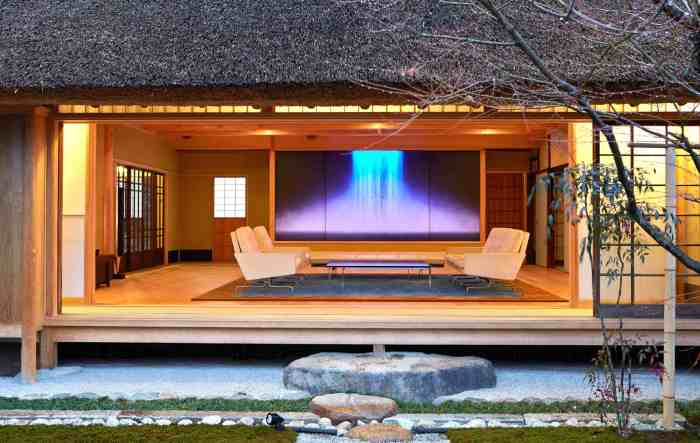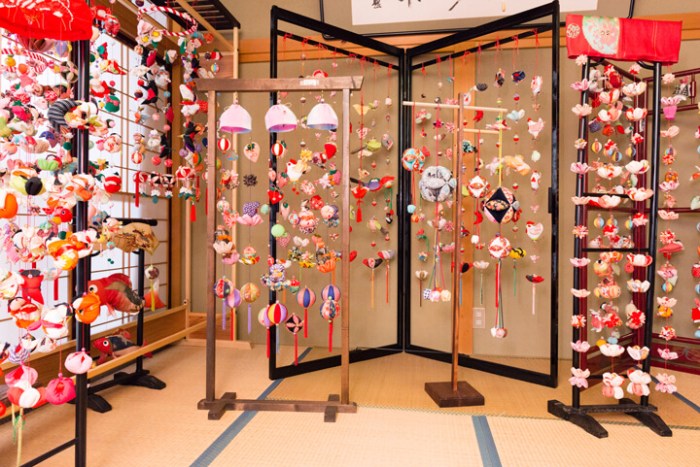Japanese Decorations: From ancient temples to modern minimalist homes, Japanese aesthetics have captivated the world for centuries. This rich decorative tradition, shaped by history, philosophy, and nature, reveals itself through intricate motifs, carefully selected materials, and a profound respect for craftsmanship. Explore the evolution of these styles, from the vibrant colors of the Edo period to the understated elegance of wabi-sabi, and discover the cultural significance woven into every design.
This exploration delves into the key elements and motifs, the diverse types of decorative items, and the distinct styles that define Japanese aesthetics. We’ll examine the symbolic meanings behind common motifs like cherry blossoms and cranes, and uncover the artistry and skill involved in creating traditional pieces. Furthermore, we will investigate how these ancient traditions are reinterpreted in contemporary design, showcasing the enduring appeal of Japanese decorative arts.
History and Evolution of Japanese Decorations

Japanese decorative arts boast a rich and multifaceted history, deeply intertwined with the nation’s cultural, religious, and social transformations. From the understated elegance of early periods to the vibrant exuberance of later eras, Japanese aesthetics have consistently demonstrated a remarkable ability to adapt and evolve while retaining a core essence of beauty and functionality. This evolution reflects not only changing artistic sensibilities but also the impact of significant historical events and the ongoing interaction with other cultures.
The development of Japanese decorative styles can be broadly traced through distinct historical periods, each characterized by unique aesthetic principles and artistic expressions. Influences ranged from indigenous traditions and philosophies to the adoption and adaptation of foreign styles, resulting in a dynamic and constantly evolving artistic landscape.
Heian Period (794-1185): Refined Elegance and Naturalism
The Heian period, a time of relative peace and cultural flourishing, witnessed the development of a refined and elegant aesthetic. Decorative arts emphasized understated beauty, natural motifs, and a delicate sense of harmony. Calligraphy, painting, and lacquerware flourished, showcasing subtle color palettes and graceful lines inspired by nature. The intricate designs on screens and folding screens, often depicting scenes from nature or courtly life, exemplify the period’s focus on delicate beauty and refined craftsmanship.
The use of gold leaf and silver leaf on lacquered surfaces added a touch of opulence, reflecting the aristocratic context of the period’s artistic production.
Muromachi Period (1336-1573): Zen Influence and Wabi-Sabi Aesthetics
The Muromachi period saw the rise of Zen Buddhism, which profoundly influenced artistic sensibilities. The aesthetic ideal of wabi-sabi, emphasizing the beauty of imperfection, impermanence, and naturalness, became central to decorative arts. Tea ceremony paraphernalia, such as tea bowls ( chawan) and tea caddies ( natsume), exemplified this aesthetic, often featuring asymmetrical forms, rustic textures, and subtle imperfections that were considered signs of authenticity and natural beauty.
The understated elegance and spiritual depth of wabi-sabi continue to resonate in contemporary Japanese design.
Edo Period (1603-1868): Popularization and Diverse Styles
The Edo period, a long period of peace and stability, saw a flourishing of popular arts and crafts. The rise of the merchant class fueled a demand for decorative objects, leading to a wider range of styles and techniques. Ukiyo-e woodblock prints, depicting scenes of everyday life and popular entertainment, became incredibly popular. Lacquerware, ceramics, and textiles also flourished, showcasing vibrant colors, intricate designs, and a greater emphasis on decorative elements.
The distinct regional styles that emerged during this period highlight the diversity of artistic expression across Japan.
Meiji Period (1868-1912): Western Influence and Modernization
The Meiji Restoration marked a significant turning point, as Japan rapidly modernized and opened itself to Western influences. While traditional crafts continued, new styles incorporating Western techniques and aesthetics emerged. Decorative arts incorporated elements of Western design, such as Art Nouveau and Art Deco, while still retaining distinctive Japanese characteristics. This period witnessed a fascinating blend of tradition and modernity, showcasing the adaptability of Japanese artistic traditions in the face of rapid societal change.
The integration of Western design elements into traditional forms resulted in a unique hybrid style that reflected Japan’s complex relationship with the West during this period of modernization.
Modern Interpretations of Japanese Decorations

The enduring appeal of Japanese aesthetics continues to influence contemporary design, resulting in a fascinating blend of tradition and modernity. Modern interpretations seamlessly integrate traditional Japanese decorative elements into contemporary living spaces and fashion, reflecting a global appreciation for minimalist design, natural materials, and a profound connection with nature. This fusion often involves a careful selection of colors, textures, and forms, creating environments that are both visually stunning and deeply calming.Modern Japanese-inspired design often prioritizes clean lines, functionality, and a sense of spaciousness, even in smaller spaces.
This approach reflects a core principle of Japanese aesthetics: ma, or the intentional use of empty space. This concept isn’t about emptiness, but rather the appreciation of negative space to enhance the beauty and impact of the elements present. The result is a sophisticated balance between simplicity and visual richness.
Modern Japanese-Inspired Home Decor
The incorporation of traditional Japanese decorative elements into modern homes is readily apparent in several key areas. Natural materials such as bamboo, wood, and paper are frequently used in furniture, flooring, and wall coverings. These materials introduce warmth and texture while maintaining a minimalist aesthetic. Shoji screens, traditionally used to divide rooms, are now often incorporated as room dividers or even as decorative features in contemporary interiors.
Their translucent quality allows light to filter through, creating a soft, diffused glow. Similarly, tatami mats, traditionally used as flooring, are sometimes incorporated into modern homes as accents or in dedicated spaces designed to evoke a sense of traditional Japanese serenity. Low-profile furniture, reminiscent of traditional Japanese seating, also contributes to the overall aesthetic.
Modern Japanese-Inspired Fashion
Japanese fashion design often incorporates traditional elements in innovative ways. The use of natural fabrics like silk and linen, often in muted earth tones, is a common thread. Kimono-inspired silhouettes, such as loose-fitting robes or jackets with wide sleeves, are frequently seen in contemporary clothing. The incorporation of traditional Japanese patterns, such as geometric designs or floral motifs, adds a touch of cultural heritage to modern garments.
The minimalist aesthetic found in traditional Japanese clothing is also reflected in contemporary fashion, with clean lines and simple shapes dominating many designs. Modern designers often combine these traditional elements with modern fabrics and techniques, creating unique and stylish garments that blend tradition and modernity.
Blending Traditional Japanese Aesthetics with Modern Sensibilities
Many contemporary designers successfully blend traditional Japanese aesthetics with modern sensibilities by focusing on the principles underlying traditional design. This includes the emphasis on natural materials, the use of negative space, and the appreciation for asymmetry. Modern designers often reinterpret traditional patterns and motifs, adapting them to contemporary contexts. For example, a traditional geometric pattern might be reimagined in a bold, modern color palette or applied to a contemporary piece of furniture.
The careful selection of lighting is also crucial, as it can significantly impact the overall mood and atmosphere of a space. Soft, diffused lighting, reminiscent of traditional Japanese homes, is often preferred, contributing to a sense of tranquility and serenity.
Globalization’s Impact on Japanese Decorative Styles, Japanese Decorations
Globalization has played a significant role in the evolution of Japanese decorative styles. Increased international exchange has led to a greater appreciation of Japanese aesthetics worldwide, resulting in a broader range of interpretations and adaptations. Contemporary designers from around the globe draw inspiration from Japanese design principles, incorporating them into their own unique styles. This cross-cultural exchange has resulted in a vibrant and diverse range of modern Japanese-inspired designs, reflecting the global appeal of traditional Japanese aesthetics.
The accessibility of Japanese design elements through online platforms and global retail chains has also broadened its reach and influence, further accelerating the integration of these styles into diverse cultural contexts.
Japanese decorations offer a captivating blend of artistry, symbolism, and cultural heritage. From the delicate brushstrokes of calligraphy to the serene beauty of a minimalist tea room, each piece tells a story, reflecting centuries of tradition and artistic innovation. By understanding the history, philosophy, and techniques behind these decorative styles, we gain a deeper appreciation for their enduring appeal and their ability to enrich our modern lives.
The enduring influence of Japanese aesthetics demonstrates a timeless elegance that continues to inspire and captivate designers and enthusiasts alike.